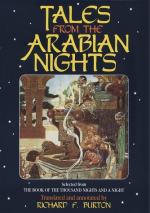[FN#264] For this scene which is one of every day in the East; see Pilgrimage ii. pp. 52-54.
[FN#265] This hate of the friend of man is inherited from Jewish ancestors; and, wherever the Hebrew element prevails, the muzzle, which has lately made its appearance in London, is strictly enforced, as at Trieste. Amongst the many boons which civilisation has conferred upon Cairo I may note hydrophobia; formerly unknown in Egypt the dreadful disease has lately caused more than one death. In India sporadic cases have at rare times occurred in my own knowledge since 1845.
[FN#266] In Galland “Rougeau” = (for Rougeaud?) a red-faced (man), etc., and in the English version “Chance”: “Bakht” = luck, good fortune.
[FN#267] In the text “Sarraf” = a money-changer. See vols. i. 210; iv. 270.
[FN#268] Galland has forgotten this necessary detail: see vol. i. 30 and elsewhere. In Lane’s story of the man metamorphosed to an ass, the old woman, “quickly covering her face, declared the fact.”
[FN#269] In the normal forms of this story, which Galland has told very badly, the maiden would have married the man she saved.
[FN#270] In other similar tales the injured one inflicts such penalty by the express command of his preserver who takes strong measures to ensure obedience.
[FN#271] In the more finished tales of the true “Nights” the mare would have been restored to human shape after giving the best security for good conduct in time to come.
[FN#272] i.e. Master Hasan the Rope-maker. Galland writes, after European fashion, “Hassan,” for which see vol. i. 251; and for “Khwajah” vol. vi. 146. “Al-Habbal” was the cognomen of a learned “Hafiz” (= traditionist and Koran reader), Abu Ishak Ibrahim, in Ibn Khall. ii. 262; for another see iv. 410.
[FN#273] “Sa’d” = prosperity and “Sa’di’ ’= prosperous, the surname of the “Persian moralist,” for whom see my friend F. F. Arbuthnot’s pleasant booklet, “Persian Portraits” (London Quaritch, 1887).
[FN#274] This is true to nature as may be seen any day at Bombay The crows are equally audacious, and are dangerous to men Iying wounded in solitary places.
[FN#275] The Pers. “Gil-i-sar-shui” (=head-washing clay), the Sindi “Met,” and the Arab “Tafl,” a kind of clay much used in Persian, Afghanistan, Sind, etc. Galland turns it into terre a decrasser and his English translators into “scouring sand which women use in baths.” This argillaceous earth mixed with mustard oil is locally used for clay and when rose-leaves and perfumes are used, it makes a tolerable wash-ball. See “Scinde or The Unhappy Valley,” i. 31.
[FN#276] For the “Cowrie” (Cyproea moneta) see vol. iv. 77. The Badam or Bidam (almond) used by way of small change in India, I have noted elsewhere.
[FN#277] Galland has “un morceau de plomb,” which in the Hindi text becomes “Shishahkapaysa” = a (pice) small coin of glass: the translator also terms it a “Faddah,” for which see Nusf (alias “Nuss"), vols. ii. 37, vi. 214 and ix. 139, 167. Glass tokens, by way of coins, were until late years made at Hebron, in Southern Syria.




